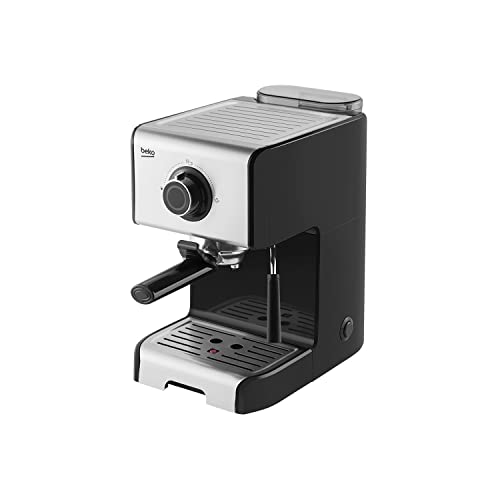Espresso Maker - A Must-Have For Home Baristas
Espresso is a strong dark-brown drink that is created by pushing hot water through tightly packed, finely ground coffee. It is the base for many popular drinks in the cafe.
A barista, also referred to as an "espresso maker" controls a number of variables to create a perfect cup. This includes the temperature of the water and its pressure as well as how tightly packed the coffee is.
Origins
The espresso maker is a machine that pushes small amounts of near boiling water under a high pressure through finely ground coffee beans. The resultant beverage is stronger than drip coffee, and is more concentrated and served in smaller cups. This is an excellent choice for those who want a strong cup of coffee but want it quickly!
In the 19th century the first espresso machines were invented. espresso machine uk was massive in the 19th century, however, brewing took a lot of time. People were impatient and desired to have a cup of coffee in a hurry!
In 1884, Angelo Moriondo from Turin invented the first coffee maker. The name of the machine was "New steam machinery, for the efficient and instantaneous preparation of coffee beverage. Method A." Moriondo."
The Milanese makers Luigi Bezzerra and Desiderio Pavoni developed and improved the machine. They incorporated the portafilter as well as a variety of brewheads, among other innovations that are still present in espresso machines today. The machine was dubbed the Ideale and was a hit with the crowds at the 1906 Milan Fair. Today, a Moka pot is found in nine of 10 Italian households.
Variations
The flavor of espresso is more intense than coffee, which is why it is a great match with milk and other ingredients to create cafe favorites like cappuccinos and lattes. Its bold flavor also shines in baked goods recipes and even marinades.
There are four types of espresso maker that include manual levers semi-automatic, automatic and super-automatic machines. Each type uses a different method to extract the espresso.
A manual lever works with a piston that is mechanically operated to press water through grounds. It's the perfect blend of the manual control and mechanized consistency. It's still necessary to grind, tamp and pull the shot yourself, but there's a lot more control over temperature and pressure.
Moka pots are a second manual espresso maker that functions similar to modern pump-driven espresso machine. Inside an airtight vessel, boiling water produces steam, which is then forced through the bottom chamber into a filter basket filled with ground coffee and into a metal filter where it is pumped into the top cup. These machines are less expensive but they can only generate 1-1.5 bars of steam pressure. This is not enough to make espresso.
Ingredients
Espresso makers can aid home baristas create cafe favorites such as cappuccinos and lattes. You can also add flavorful extracts or syrups to espresso shots for an indulgent drink like the espresso martini.

For a great cup of espresso you'll need top-quality beans, fresh milk, and sugar. Find beans specifically labeled for espresso and grind them with precision to ensure an even extraction. You can try different roasts until finding the one that best suits your preferences.
You'll need a burr grinder to grind the beans to an even texture. The espresso machine is equipped with a portafilter, which stores the grounds, and the tamper, which is used to pack the coffee tightly.
You'll also need an espresso set and a steamer to make the silky aerated-milk characteristic of espresso drinks. Certain machines have an integrated steam wand, which can make this process faster and easier. You'll also need to regularly descale the machine, which involves running an aqueous solution of vinegar and water through the system.
Techniques
Espresso brewing relies upon creating pressure to quickly extract powerful flavors from finely-ground dark-roast, dark-roast brewed coffee packed into a "puck." This method of brewing creates the strength of a coffee shot, also known as espresso. When made well espresso has a rich crema (or dense foam) over the top.
Contrary to the Moka Express that uses heat to purify water through coarsely ground coffee, most espresso makers make use of highly pressurized water pushed through small grounds under high heat. This creates an espresso-like drink that can be dilute with milk or water to make other drinks such as cappuccinos and lattes.
While the Moka Express is a basic low-cost machine, other espresso machines are complicated expensive, and come with many beverage options. The most well-known lever machines are Italian-designed and use spring-loaded arm to dispense hot cylinder water into a portafilter. A barista operating such a machine is able to control the time when he pulls the shot, adjusting factors like grind size and water temperature on a shot-by-shot basis to achieve the best results. These machines were instrumental in bringing espresso to greater acclaim throughout Italy and Europe.
Equipment
A good espresso machine should be able to extract soluble and non-soluble solids from finely grinded tightly packed coffee. This process is aided by controlled variables and pressure, like temperature and grind size. Then there's the flavor which is influenced by various factors, including the beans as well as the way they're handled and made.
There are several different types of espresso machines, however the semiautomatic model is the most well-known. It uses an electric pump to push the water through the grounds. The user can also do the grinding and tamping. These machines are generally the most affordable but aren't as reliable as spring pistons or other manual designs.
The higher priced lever models have an equilibrated piston that does the work for you. They're a bit more accommodating than spring piston machines however they still require some expertise to use correctly. These machines require a lot more maintenance. It is necessary to warm up the portafilter and then remove the portafilter and the piston each time.
